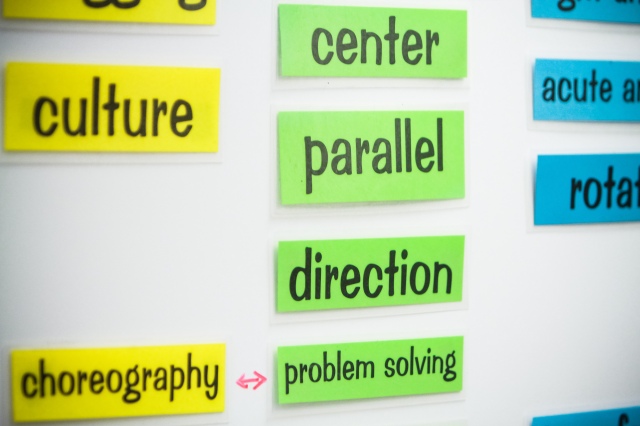
“The first reason to read aloud to older kids is to consider the fact that a child’s reading level doesn’t catch up to his listening level until about the eighth grade,” said Trelease [a Boston-based journalist, who turned his passion for reading aloud to his children into The Read-Aloud Handbook in 1979], referring to a 1984 study performed by Dr. Thomas G. Sticht showing that kids can understand books that are too hard to decode themselves if they are read aloud. “You have to hear it before you can speak it, and you have to speak it before you can read it. Reading at this level happens through the ear.”
Did you catch that? “You have to hear it before you can speak it, and you have to speak it before you can read it.”
I made a similar point while working with teachers and teaching artists in Minnesota in 2013 when participants noticed how the math language was woven naturally and seamlessly into our dance work. This vocabulary development, I said, was initially an attempt to help kids pay closer attention to the details of what they were doing while they created their dance patterns. I noticed that they became much better creators when they had the right words to help them identify their movement choices.
“Comprehension of a word’s meaning involves not only the ‘classic’ language brain centres but also the cortical regions responsible for the control of body muscles, such as hand movements.”
“An alternative is offered by an embodied or distributed view suggesting that the brain areas encoding the meaning of a word include both the areas specialised for representing linguistic information, such as the word’s acoustic form, but also those brain areas that are responsible for the control of the corresponding perception or action. On this account, in order to fully comprehend the meaning of the word ‘throw’, the brain needs to activate the cortical areas related to hand movement control. The representation of the word’s meaning is, therefore, ‘distributed’ across several brain areas, some of which reflect experiential or physical aspects of its meaning.”
My take away from the study overview is this:
- Our whole bodies are just that: whole systems working in an fascinating and astoundingly connected ways.
- “Knowing” something, especially the ideas and concepts on the action side of math (transform, rotate, reflect, compose, sequence, combine, etc) is strengthened by the partnership between mathematical language and physical experience.
In Math in Your Feet we start by moving to get a sense of the new (non-verbal) movement vocabulary in our bodies. At the same time we say together, as a group and out loud, the words that best match our movement. Sometimes we also pay attention to the words’ written forms on the board so all three modalities of the idea are clear to us. When learners are more confident with their dancing they are asked to observe others’ work and choose the the specific words that describe the attributes/properties of the moving patterns. There are over 40 video examples of this in action in Math on the Move.

In addition to being able to parse our patterns, we use tons of other math terminology while we choreograph in conversations with our teammates and in whole group discussions. This approach allows learners to fully grasp the real meaning and application of these ideas which, ultimately, allows them to write and talk confidently about their experiences making math and dance at the same time. Teachers consistently notice an increase of ‘math talk’ in their classrooms when children get up to explore math ideas with their whole bodies. As in, “I couldn’t believe how much math vocabulary they were using!”
BIG PICTURE #1
Math is a language but it’s not just about terminology, it’s about what those words MEAN. To do this, learners need to play with mathematical ideas, notice and talk about patterns and structure, sort and compare, and share reasoning about and understanding of mathematical relationships.
BIG PICTURE #2
As such, language, in partnership with the body is our tool for thinking mathematically when we are up out of our seats and moving during math time. Ideally, this language is facilitated by an adult through conversation, play and exploration, all before bringing it to the page to explore the ideas in a different modes and contexts.
Malke Rosenfeld is a dance teaching artist, author, editor, math explorer, and presenter whose interests focus on the learning that happens at the intersection of math and the moving body. She delights in creating rich environments in which children and adults can explore, make, play, and talk math based on their own questions and inclinations. Join Malke and other educators on Facebook as we build a growing community of practice around whole-body math learning.

Pingback: The Cognitive and Intellectual Aspects of Dance (and math) – Math on the Move
Pingback: An example of math & art as a universal language – Math in Unexpected Spaces